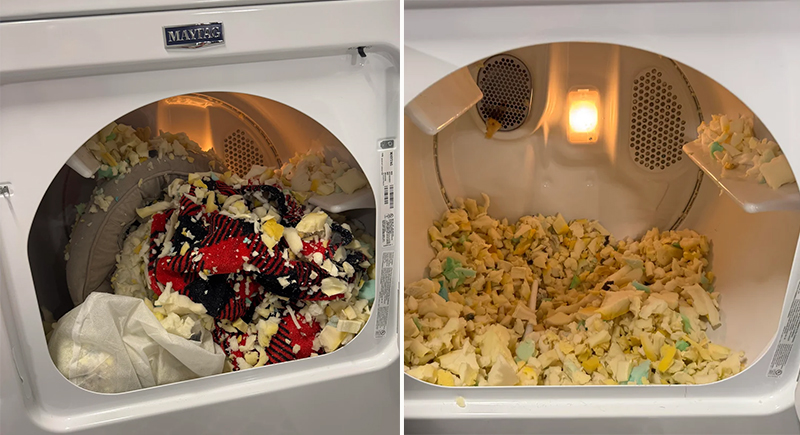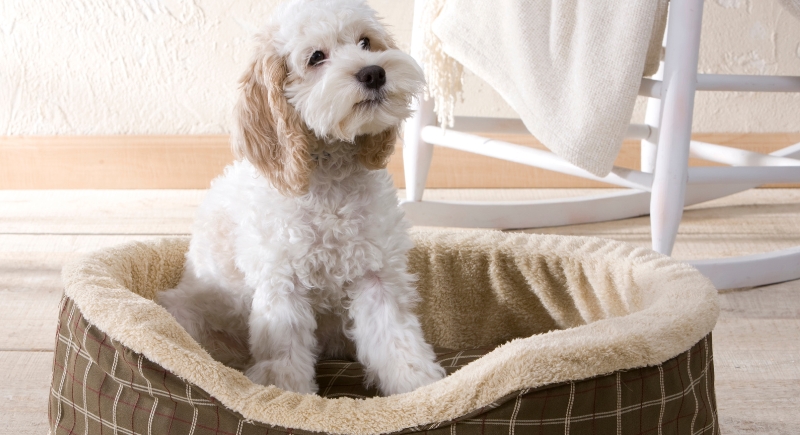What Happens When You Put a Dog Bed in the Dryer? The Answer Is a Mess
A dog bed doesn’t seem much different from a big pillow. But looks can be deceiving. Anyone who has tried tossing one straight into the dryer has probably learned the hard way that it doesn’t end well. That lesson hit home for thousands of people after a Reddit post went viral: a foam-filled bed burst apart mid-cycle.
It was a striking reminder that pet bedding isn’t built to handle the same treatment as everyday laundry. The materials inside are meant to cushion and support, not withstand heat and tumbling. When those two worlds collide, the outcome is almost always a disaster—messy, frustrating, and potentially risky.
The Viral Photo That Started the Conversation

Image via Reddit/K9Kush
The now-famous photo that circulated online showed a dryer bursting with bits of yellow filling, almost like popcorn overflowing from a pan. The original poster explained that their spouse put the bed straight into the appliance, and the liner failed, which released shredded foam everywhere.
The comments ranged from jokes about “popcorn” to serious warnings about potential machine fires. People pointed out that many beds are built with zippers for a reason because they allow the cover to be removed safely while protecting the stuffing inside.
That image became a cautionary lesson for thousands of dog owners and reminded them that beds need specific care to avoid a cleanup nightmare.
Why Foam Beds Fall Apart in the Dryer
Dog beds with memory foam or shredded foam cores are not designed to withstand heat and tumbling. The internal liners that hold the filling can tear when exposed to constant rotation. Once this happens, the stuffing spreads throughout the drum and sometimes into the vents.
Taking it off requires significant effort and still leaves small fragments. These particles pose more than a care problem because clogged filters or vents can increase the risk of overheating and fire. Even when the bed appears intact, repeated exposure to machine heat causes the filling to lose shape and reduces the support it provides for a dog’s joints.
How to Wash Dog Beds Safely

Image via Getty Images/Triton21
Proper maintenance depends on the type of bed. If the bed has a removable cover, unzip it and machine wash the cover separately in hot water using a mild, pet-safe detergent. An additional rinse cycle helps get rid of residue that could irritate sensitive skin.
For beds without removable covers, submerging them in a bathtub or large basin works best. Add detergent, soak for at least thirty minutes, and then use a soft brush to scrub before rinsing thoroughly. Always vacuum the bed beforehand, because clumps of fur and dirt can clog washing machines.
If you are hoping for odor removal, sprinkle baking soda before vacuuming or use an enzyme-based spray designed for pet messes. This approach eliminates bacteria while preserving fabric integrity.
How Often Should You Wash Your Dog Beds
Where washing frequency is concerned, it should match a dog’s lifestyle: beds for active outdoor dogs often require weekly washing, while indoor-only pets may only need laundering every two weeks.
However, in case you leave the beds as they are for prolonged periods of time, there may be unpleasant consequences. Studies have shown they can harbor bacteria, fungi, parasites, and even viruses capable of surviving for months. Fleas also often lay eggs in bedding and make it a breeding ground for infestations. For dogs with cuts or skin irritation, lying in a contaminated bed raises the chance of infection, too.
Keep in mind that beds that look clean may still hold invisible threats, and neglecting them contributes to larger household hygiene issues. Addressing these hidden hazards ensures not only comfort for the dog but also a healthier home for the family sharing space with them.